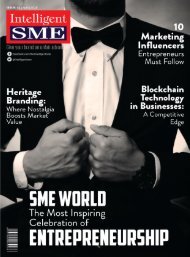Innovation i tech High
Create successful ePaper yourself
Turn your PDF publications into a flip-book with our unique Google optimized e-Paper software.
DIGITAL ECOSYSTEM<br />
our friends are doing across<br />
the world?<br />
Are we sacrificing our native<br />
habitat for the short-term<br />
exhilaration of change?<br />
We see this conflict all around<br />
us. Instead of enjoying<br />
sunsets, humans are “more<br />
focussed on merging<br />
themselves into a frame with<br />
the setting sun in the form of<br />
a “selfie” while thousands of<br />
tonnes of toxic ‘e-waste’ are<br />
being dumped in wetlands<br />
each year. Words such as<br />
'acorn', 'adder' and 'willow'<br />
have been eliminated from<br />
the Oxford Junior Dictionary<br />
to make way for 'broadband',<br />
'analogue' and 'cut and<br />
paste'.<br />
We complain about the<br />
colonisation of our wild places<br />
with wifi, yet declare internet<br />
access to be a human right.<br />
We dream of relaxing on<br />
tranquil Seychelles islands,<br />
but demand unsustainably<br />
cheap flights to get us there.<br />
No wonder we're so<br />
conflicted.<br />
As the scientific philosopher<br />
Christopher Potter points out<br />
in his book “How To Make<br />
A Human Being, “Humans<br />
never were part of nature.<br />
We were always part of<br />
<strong>tech</strong>nology.”<br />
From the moment modern<br />
humans harnessed the power<br />
of fire, it put us on a path to<br />
global domination and we<br />
never looked back.<br />
Having said that, more<br />
humans today than ever<br />
before are waking up to the<br />
new realities.<br />
Although many of our digital<br />
inventions serve to estrange<br />
us from the world they were<br />
created to enrich, <strong>tech</strong>nology<br />
and nature are also<br />
continually cross-pollinating<br />
in powerfully positive ways.<br />
It is also important to<br />
discuss the use of <strong>tech</strong> to<br />
support conservation and<br />
sustainability projects.<br />
Technology For Nature is a<br />
unique partnership between<br />
Zoological Society of London,<br />
University College London<br />
and Microsoft Research<br />
designed “to rapidly scale<br />
up our global conservation<br />
response” by bringing<br />
together <strong>tech</strong>nologists and<br />
zoologists.<br />
Current projects include<br />
FetchClimate, a fast, free,<br />
cloud-based service that<br />
allows experts to access<br />
accurate climate change<br />
data from any geographical<br />
region around the world, and<br />
Mataki, which develops new<br />
devices for recording the<br />
behaviour of animals in the<br />
wild.<br />
The conservation issues<br />
we most urgently need to<br />
tackle right now include<br />
the monitoring of protected<br />
areas, tracking of species<br />
with a high commercial value,<br />
and the online detection<br />
of illegal wildlife trading.<br />
In the past 10 years, our<br />
emerging ability to achieve<br />
near constant monitoring of<br />
valuable natural assets, such<br />
as protected areas and rhinos<br />
has created a powerful nexus of<br />
information<br />
Of course, nature isn’t all<br />
puppies and waterfalls, and <strong>tech</strong><br />
is also helping people manage<br />
her crueller side. Hashtagged<br />
tweets and geotagged<br />
Instagram photos have become<br />
a valuable way to share real-time<br />
updates as natural disasters<br />
unfold. Google’s Person<br />
Finder, which was created to<br />
reunite relatives during 2011’s<br />
Japanese tsunami, is currently<br />
live in Nepal. And various<br />
apps like Federal Emergency<br />
Management Agency’s (FEMA’s)<br />
app, allow stricken communities<br />
to crowdsource crisis relief.<br />
Consider the field of biomimetics,<br />
where natural design elements<br />
and processes are used as<br />
a model for new materials,<br />
devices and tools. One famous<br />
historic example is the invention<br />
of Velcro, which was developed<br />
by Swiss engineer Georges de<br />
Mestral in 1941 after he observed<br />
how cockleburs in the mountains<br />
caught on his clothing and in his<br />
dog's fur.<br />
In the field of construction,<br />
companies such as ours focus<br />
on sustainable methods and<br />
push environment-friendly<br />
designs with use of sustainable<br />
materials. Together with<br />
visionary architects, engineers<br />
and suppliers we need to devise<br />
sustainable and commercially<br />
viable alternatives to traditional<br />
construction materials.<br />
During the entire lifecycle of a<br />
construction project, we help<br />
developers decide what to do with<br />
INNOVATIONANDTECH<br />
January | 2018<br />
41






